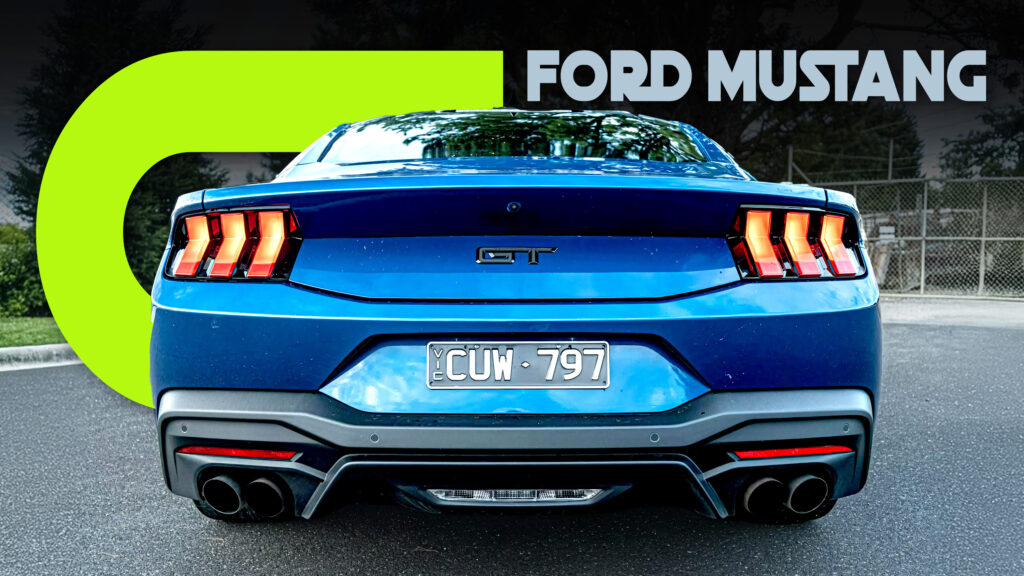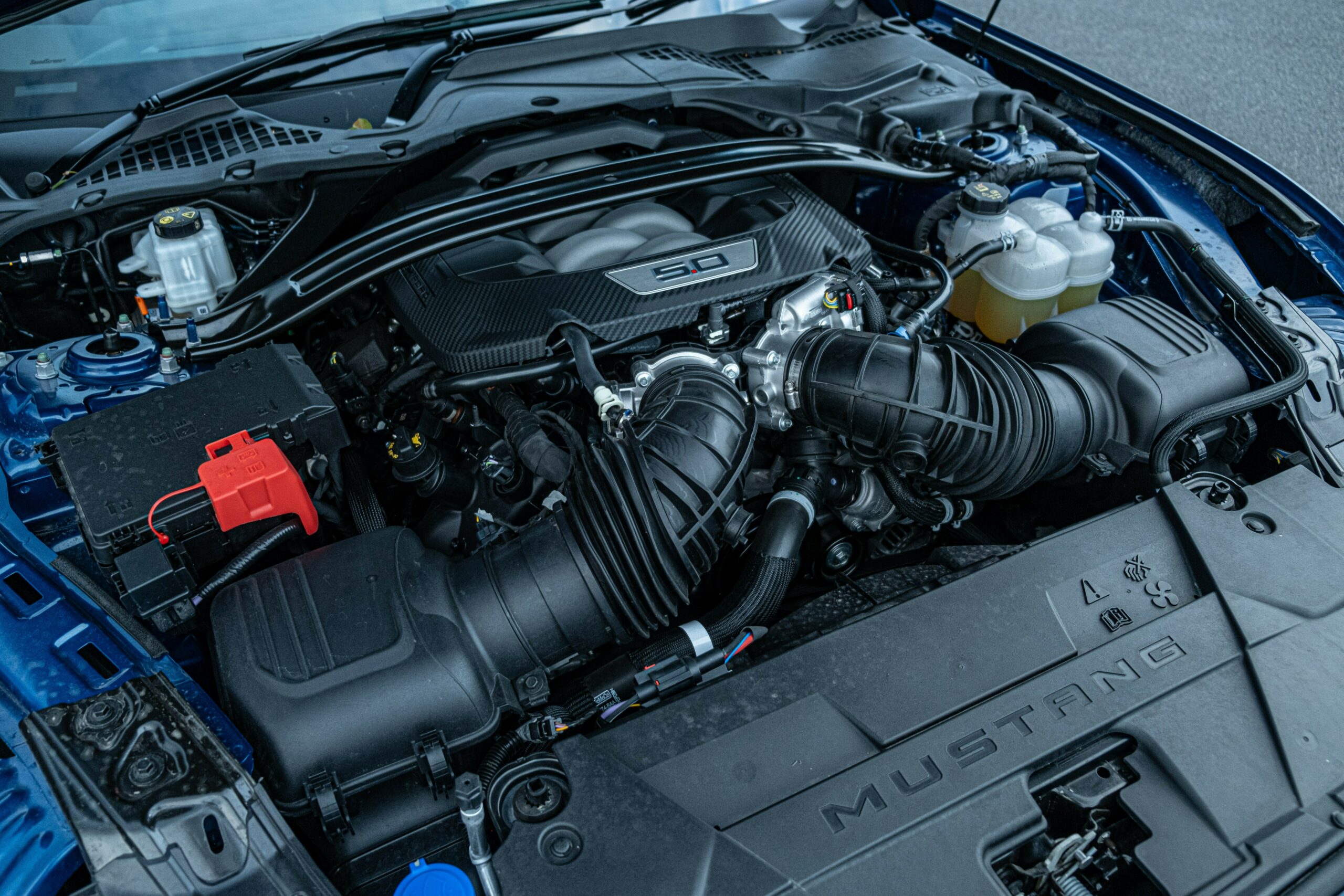The S650 Ford Mustang is the last of a dying breed. With Chevrolet’s Camaro sent to the great junkyard in the sky and the Dodge Challenger now a mere footnote in history, Ford has effectively become the last man standing in the V8 muscle car game. At least until the ICE Dodge Charger makes its comeback – but that one will debut with a straight-six turbo, unless those Hemi rumors actually turn out to be true.
It’s a crying shame that two of America’s most loved performance cars have been shelved, but Ford deserves credit for launching the seventh-generation Mustang, keeping the muscle car dream alive.
Review: Ford Ranger Raptor Shouldn’t Be This Fun, Yet Here We Are
Like before, the range starts with the EcoBoost-powered model and rises to the V8-powered GT, the potent Dark Horse, and the motorsport-derived GTD flagship. However, it’s the GT that remains the true backbone of the Mustang lineup, and it’s this version we recently took for a spin.
So, the question is: does the new Mustang live up to its iconic nameplate? And does it still hold up as a compelling performance car, or has it run its course?
QUICK FACTS
Photos Brad Anderson/Carscoops
Like in the US, Ford sells the 2025 Mustang in Australia in both EcoBoost and GT guises, while also selling the Dark Horse in limited numbers. Prices start at AU$74,452 (~$47,400) for the EcoBoost and rise to AU$88,388 (~$56,300) for the GT that we drove, putting it in a unique spot in the market with very few direct rivals.
Whereas there could be a little bit of cross-shopping between a Mustang Dark Horse and a C8 Corvette in the US, in Australia, the C8 is roughly double the price of a Dark Horse. Perhaps the two nearest rivals to the Mustang GT are the Toyota Supra and Nissan Z, both of which can be ordered with a six-speed manual. The Supra GT starts at AU$94,378 (~$60,100), while the Z starts at AU$82,655 (~$52,700) with the manual. However, both are smaller than the Ford and use boosted six-cylinder engines, rather than a V8.
It’s perhaps the Ford’s distinctive place in the market that made the sixth-gen car so successful in Australia, and for many years, the world’s best-selling sports car. The Blue Oval has stuck with this tried-and-tested formula for the S650.

Like the previous gen, the new one is powered by the 5.0-liter naturally-aspirated Coyote V8. However, several internal revisions have been made to it. These include dual throttle bodies, a new air intake, and a four-into-one exhaust manifold, allowing it to deliver 462 hp (345 kW) at 7,250 rpm and 405 lb-ft (550 Nm) with the active performance exhaust that all Aussie-spec GTs get as standard. These figures are down slightly on GTs sold in the States, but make no mistake; the car is plenty powerful.
The V8 is mated to either a six-speed Getrag manual or a 10-speed automatic. Our tester had the stick shift, sending all of its (considerable) power to the rear wheels.
Photos Brad Anderson/Carscoops
I’ll let you be the judge of the exterior design of the new Mustang. For what it’s worth, I find the sixth-gen’s styling more to my liking, but there’s no denying the 2025 model looks purposeful. One area that does represent a massive leap forward is the cabin.
Ford has done a brilliant job of bringing the Mustang into the modern era with a vastly improved interior. Not only is it much nicer than the old car, but it’s one of the finer cabins of any of the brand’s models.
More: This Off-Road Mustang Raptor Could Be Built, If Enough Of You Show Interest
Dominating the cabin is a 12.4-inch digital instrument cluster and a 13.2-inch infotainment screen. Yes, these two screens are just like the same twin systems you’ll find in everything nowadays, but they are bright, colorful and, perhaps most importantly, highly configurable.
Photos Brad Anderson/Carscoops
The instrument cluster has an array of different themes that can be set manually or linked to the driving mode. For 2025, it’s also received gauges to mimic the setup of the 1967-1968 Mustang, the 1987-1993 Foxbody, and the 1999-2001 Mustang SVT Cobra. It’s also possible to customize the primary and secondary colors of the available digital gauges, which is not something I’ve seen before.
Read: Ford Mustang GTD Buyers Can’t Flip For Two Years, Then It’s Game On
The main infotainment display is where you’ll find wireless Apple CarPlay and Android Auto, access to all vehicle settings, the Track Apps menu, and, unfortunately, all the climate control settings. Thankfully, the screen is clear and responsive.
Also new for the latest-gen Mustang is a chunky flat-bottomed steering wheel and the Drift Brake. It mimics the look of a traditional handbrake, but on the road, it functions the same as a simple push-button electronic e-brake would. Gently pull it up, and the brake will turn on. Gently push down, and it’ll disable the brake. To actually use it for the intended function, you need to enable the Drift Brake function, and it’ll slam on the rear brakes, helping drivers to kick out the car’s tail.

Our tester was fitted with the available leather-clad Recaro seats. They are chunky and don’t look overly sporty, but offer heaps of bolstering and hold you well in place. Curiously, they have an electric sliding function and electrically adjustable lumbar support but only manual adjustment for the backrest. For this price, it’s also a shame they don’t come with heated and ventilated functions.
Review: Subaru BRZ tS Is A Blast For The Young And Young At Heart
As with the previous Mustang, the two tiny rear seats of the new car are only suitable for very small children… without legs.
How Does The New Mustang Drive?
Photos Brad Anderson/Carscoops
Of course, this is a Mustang, the last thing you want to read about is the practicalities, right? What you really want to know is how this thing drives. To put it simply, it’s a beast.
The soundtrack dominates the experience. The Coyote V8 has been adored by enthusiasts for years, and it’s no surprise why. It revs through to an impressive 7,500 rpm, and man, does it sound good. Or does it?
From behind the wheel, the 5.0-liter V8 seems silent. Of course, it’s not, but the roar of that engine is completely drowned out by the exhaust, regardless of whether the exhaust is in one of its tamer modes or in Track Mode. Whether or not this is a good thing depends on your preference. I’d have liked to hear more engine sound and less exhaust roar, but plenty of people will disagree. As far as exhausts go, there’s nothing on the market that can match the deep bellow and roar of the Mustang when the valves open up.
This engine loves to rev, and there’s plenty of time to enjoy it at higher revs because of the six-speed manual. Unlike the 10-speed auto that snaps through gears, the manual holds on to them for what seems like an eternity. First pulls through until about 85 km/h (53 mph), and at the top of second, you’ll be doing 130 km/h (81 mph). As such, at low revs, the GT doesn’t pull as hard as you might expect, and it’s not until above 4,000 rpm that it really gets a move on.

The ’Stang is plenty quick in a straight line, although it won’t snap your neck. The best 0-100 km/h (0-62 mph) time we could achieve with a GPS timer was 5.1 seconds, but a couple of tenths could be shaved off if I launched it more aggressively. There is a launch control function, but it’s noticeably slower, averaging 5.7-5.8 seconds to reach the same mark.
Keen driving enthusiasts would be crazy not to go with the six-speed manual. Yes, it could do with a quicker diff ratio, but everything else about the transmission is superb. The clutch is relatively heavy but has a predictable engagement point and is paired perfectly with a hefty shifter and short throws. The shifting action is positive, and it’s practically impossible to miss a gear. An automatic rev-matching function is also standard and blips the throttle beautifully.
The gearbox is also very forgiving and is unphased by clumsy shifts or reckless clutch inputs. There’s even a flat-foot shifting function, which is pretty cool.

I didn’t have particularly high hopes when it came to the handling stakes. Much to my surprise, the new Mustang feels right at home on a twisty road. It’s shod in hefty 255/40 R19 Pirelli P Zeros at the front and 275/40 rubber at the rear, giving it plenty of grip.
Nevertheless, this being a Mustang, it’s easy to unsettle the rear, but only if traction control is disabled. With it turned on, you can be greedy on the throttle and thread this thing through corners with heaps of confidence thanks to the nicely working electronic “guardian”.
However, there’s no hiding the car’s near-4,000 lbs curb weight or its size. It feels quite big and hefty on the road.
I ended my week with the Mustang sitting at 16.5 l/100 km (14.2 US mpg). That’s pretty horrendous, but it was more of a reflection on how I was driving rather than the car itself. On the highway, the Coyote V8 can be quite efficient. During one highway trip at 100 km/h (62 mph), it sipped just 7.3 l/100 km (32.2 US mpg).
Less than 5 minutes after picking up the keys to the car, however, I was almost rear-ended due in part to the over-alert front collision avoidance system. While waiting at a set of traffic lights and making a right turn, the car ahead of me slowed to perform a U-turn. I saw it and slowed enough to let it make the turn. However, the collision avoidance system slammed on the brakes, forcing the truck behind me to lock up to avoid hitting me. I made sure to turn off this setting each time I jumped into the driver’s seat.

Verdict
The changes made to the new Mustang GT don’t completely transform the way it drives, but it does feel a little more precise in every regard over its predecessor. The fabulous Coyote V8 remains as exciting as ever, sending vibrations through the cabin that’ll get any car enthusiast excited. Who knows how long cars like this will last, so we better enjoy them while we can.
More: The Most American-Made Cars Least Affected By Trump’s 25% Tariffs
It also doubles as a comfortable and premium cruiser, making it perfect for long highway journeys. Its Japanese rivals are smaller and feel sportier, but there’s nothing quite like the new Mustang on the market.






















































































































